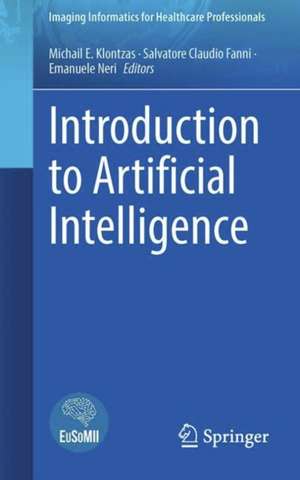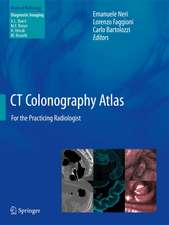Introduction to Artificial Intelligence: Imaging Informatics for Healthcare Professionals
Editat de Michail E. Klontzas, Salvatore Claudio Fanni, Emanuele Nerien Limba Engleză Paperback – 16 sep 2023
It will be a valuable resource for radiologists, computer scientists and postgraduate students working on medical image analysis.
Preț: 486.97 lei
Preț vechi: 512.60 lei
-5% Nou
Puncte Express: 730
Preț estimativ în valută:
93.19€ • 96.94$ • 76.94£
93.19€ • 96.94$ • 76.94£
Carte disponibilă
Livrare economică 22 martie-05 aprilie
Livrare express 08-14 martie pentru 27.27 lei
Preluare comenzi: 021 569.72.76
Specificații
ISBN-13: 9783031259272
ISBN-10: 3031259270
Pagini: 165
Ilustrații: VIII, 165 p. 21 illus., 20 illus. in color.
Dimensiuni: 127 x 203 x 11 mm
Greutate: 0.3 kg
Ediția:1st ed. 2023
Editura: Springer International Publishing
Colecția Springer
Seria Imaging Informatics for Healthcare Professionals
Locul publicării:Cham, Switzerland
ISBN-10: 3031259270
Pagini: 165
Ilustrații: VIII, 165 p. 21 illus., 20 illus. in color.
Dimensiuni: 127 x 203 x 11 mm
Greutate: 0.3 kg
Ediția:1st ed. 2023
Editura: Springer International Publishing
Colecția Springer
Seria Imaging Informatics for Healthcare Professionals
Locul publicării:Cham, Switzerland
Cuprins
What is Artificial Intelligence: History and Basic Definitions.- Programming Languages and Tools Used for AI Applications.- Introduction to Traditional Machine Learning.- Machine Learning Methods for Radiomics Analysis.- Natural Language Processing (NLP).- Deep Learning.- Data Preparation for AI Purposes.- Current Applications of AI in Medical Imaging.
Notă biografică
Michail E. Klontzas is the chief resident of the Radiology residency program at the University Hospital of Heraklion and collaborating researcher of the Institute of Computer Science of the Foundation for Research and Technology (ICS-FORTH, Greece). He holds a PhD from Imperial College London, an MD from the University of Crete and has worked as a postdoctoral researcher at Emory University School of Medicine. His research interests lie within musculoskeletal radiology with emphasis on radiomics and artificial intelligence. He is a member of the trainee Editorial Board of Radiology: Artificial Intelligence (RSNA), elected board member of EuSoMII and member of the board of the Radiology Trainee Forum of the ESR. He has published > 55 PubMed-indexed articles, six book chapters for international publishers and his work has been presented in conferences in Europe and the USA.
Salvatore Claudio Fanni is a young third-year radiology resident of theAcademic of Radiology at the University of Pisa. He has published Pub-med indexed articles, and chapters for international publishers, and actively participated in national and international conferences. His major research interests are thoracic radiology, in particular quantitative CT, and Natural Language Processing applications in Radiology. He is a member of the young club committee of EuSoMII and collaborates with the Imaging Lab in Pisa on many EU projects.
Emanuele Neri is full Professor of Radiology, Chairman of the Radiology Department at Pisa University Hospital, and Chair of the Post-Graduate School of Radiology and Faculty of Diagnostic Imaging of the University of Pisa. Published more than 170 papers, and 6 books, in the fields of Imaging Informatics, Gi Tract, Head and neck and oncologic imaging.
He is a member of national and international societies in the field of radiology, and President-elect of the European Society of Oncologic Imaging. Lead the Imaging Laboratory of the University of Pisa, involved in several EU projects.
Salvatore Claudio Fanni is a young third-year radiology resident of theAcademic of Radiology at the University of Pisa. He has published Pub-med indexed articles, and chapters for international publishers, and actively participated in national and international conferences. His major research interests are thoracic radiology, in particular quantitative CT, and Natural Language Processing applications in Radiology. He is a member of the young club committee of EuSoMII and collaborates with the Imaging Lab in Pisa on many EU projects.
Emanuele Neri is full Professor of Radiology, Chairman of the Radiology Department at Pisa University Hospital, and Chair of the Post-Graduate School of Radiology and Faculty of Diagnostic Imaging of the University of Pisa. Published more than 170 papers, and 6 books, in the fields of Imaging Informatics, Gi Tract, Head and neck and oncologic imaging.
He is a member of national and international societies in the field of radiology, and President-elect of the European Society of Oncologic Imaging. Lead the Imaging Laboratory of the University of Pisa, involved in several EU projects.
Textul de pe ultima copertă
This book aims to provide physicians and scientists with the basics of Artificial Intelligence (AI) with a special focus on medical imaging. The contents of the book provide an introduction to the main topics of artificial intelligence currently applied on medical image analysis. The book starts with a chapter explaining the basic terms used in artificial intelligence for novice readers and embarks on a series of chapters each one of which provides the basics on one AI-related topic. The second chapter presents the programming languages and available automated tools that enable the development of AI applications for medical imaging. The third chapter endeavours to analyse the main traditional machine learning techniques, explaining algorithms such as random forests, support vector machines as well as basic neural networks. The applications of those machines on the analysis of radiomics data is expanded in the fourth chapter to allow the understanding of algorithms used to build classifiers for the diagnosis of disease processes with the use of radiomics. Chapter five provides the basics of natural language processing which has revolutionized the analysis of complex radiological reports and chapter six affords a succinct introduction to convolutional neural networks which have revolutionized medical image analysis enabling automated image-based diagnosis, image enhancement (e.g. denoising), protocolling etc. The penultimate chapter provides an introduction to data preprocessing for use in the aforementioned artificial intelligence applications. The book concludes with a chapter demonstrating AI-based tools already in radiological practice while providing an insight about the foreseeable future.
It will be a valuable resource for radiologists, computer scientists and postgraduate students working on medical image analysis.
It will be a valuable resource for radiologists, computer scientists and postgraduate students working on medical image analysis.
Caracteristici
Provides an introduction to the basics of artificial intelligence for medical imaging professionals Written in minimally technical language to enable the comprehension of complicated computer science concepts Offers a basis for healthcare professionals aiming to apply AI in their everyday clinical or research practice

























